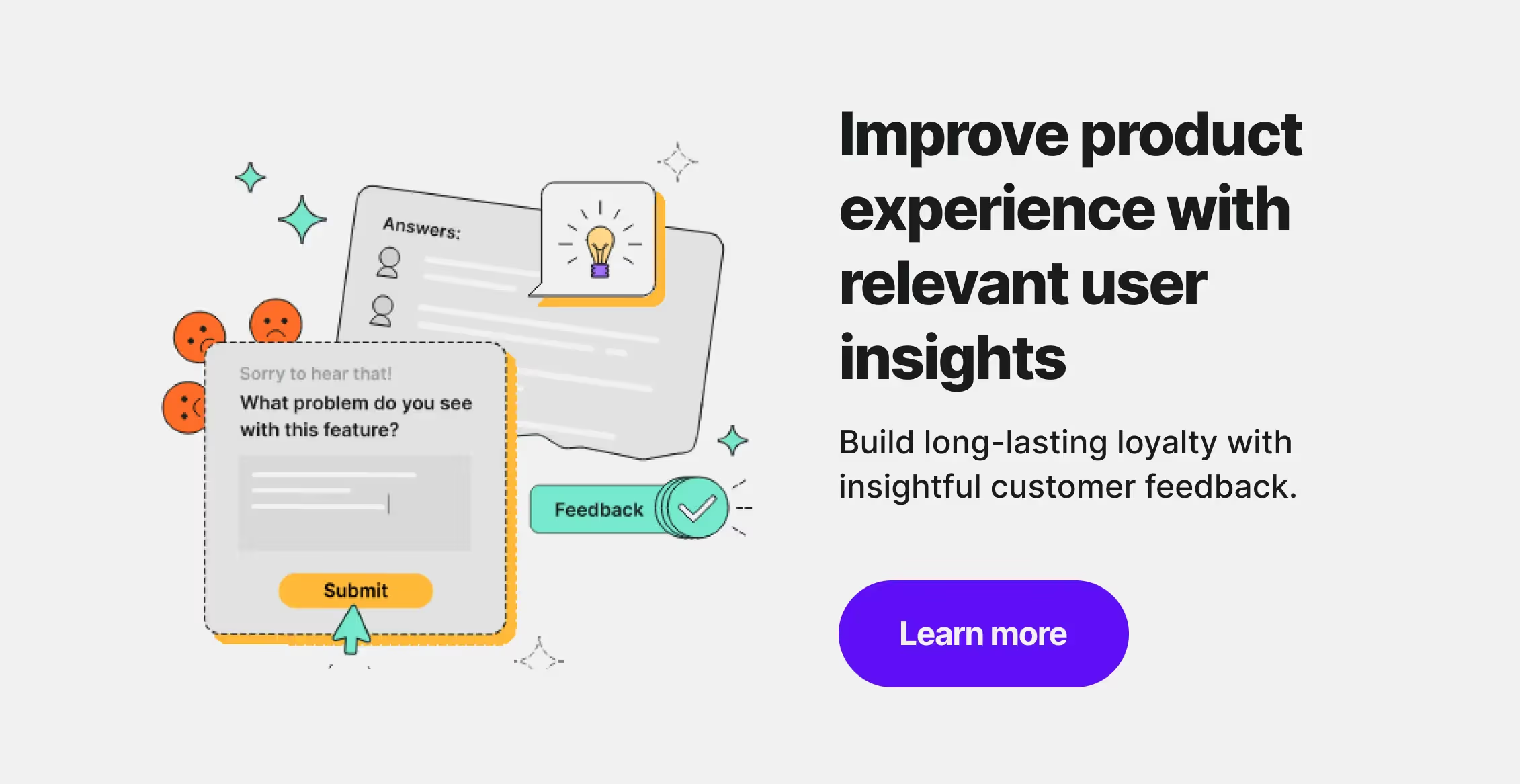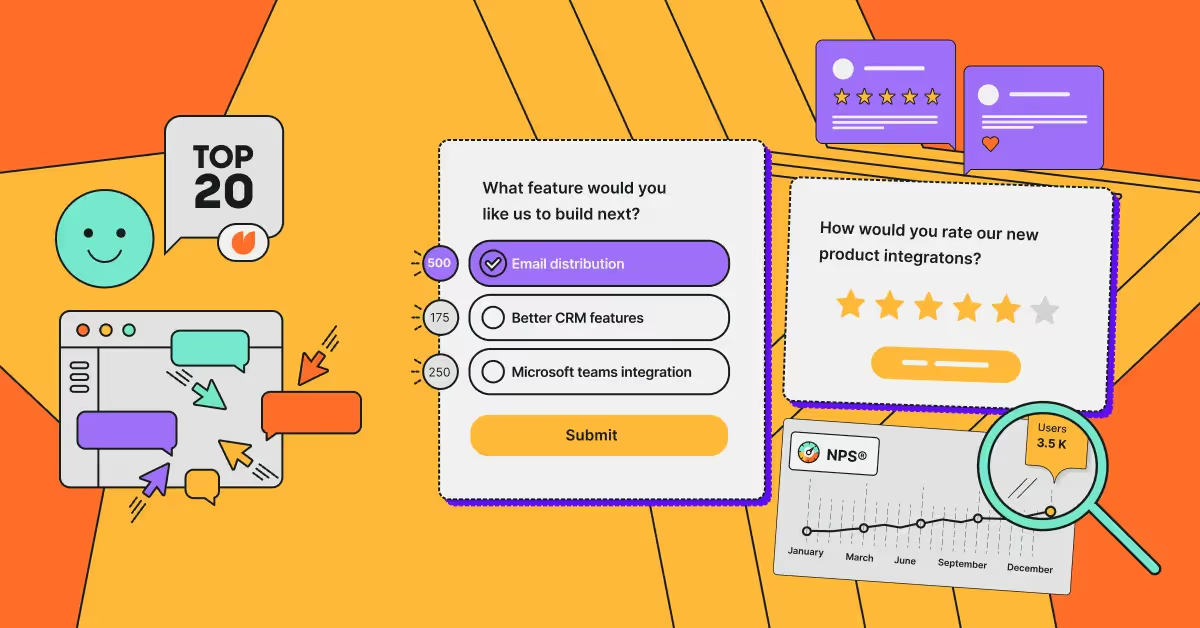TL;DR
- Product experience management (PXM), crucial for customer satisfaction and retention, encompasses usability, design, functionality, and emotional engagement. It impacts user loyalty, brand advocacy, and business growth, especially in SaaS sectors.
- For the best PXM, utilize analytics and customer feedback to measure and improve product experience. This involves tracking user engagement, analyzing behavior, integrating customer feedback, and constantly refining the product.
- Product experience should be user-centered, intuitive, consistent across platforms, and perform reliably. Privacy and security are critical to maintaining trust and enhancing the user experience.
- Map out the customer journey, analyze product interactions to identify improvement areas, and evaluate user feedback to make informed enhancements. This helps in creating a seamless, engaging, and satisfying product experience.

What is Product Experience Management?
Product Experience Management (PXM) refers to the strategic approach businesses use to manage and optimize the entire product experience for customers across multiple touchpoints and channels. The goal of PXM is to ensure that customers have a consistent, accurate, and engaging experience with a product, from discovering it online or in-store, through the buying process, and during post-purchase use.
But, before we go into detail, what is product experience?
Product experience refers to the overall impression and emotional impact that a user has when interacting with a product, encompassing every aspect of the user's interaction with the product. That's why product teams should focus on optimizing customer experience at all stages: from users first discovering it to using it and integrating it into their daily lives.
Exceptional product experience includes top-notch usability, straightforward design, highest functionality, uninterrupted performance, and the product's value to the user.
For SaaS (Software as a Service) companies, product experience is vital to customer success. The impact of the user interface and the way customers interact with your product directly influences customer satisfaction.
Effective user onboarding is crucial to drive customer loyalty and promote product led growth. Thanks to this aspect of product adoption the first steps can help to notice product value. The faster users reach their aha moment, the bigger the chance they will continue to use your product and upgrade.
Why is Product Experience Management Important?
Product experience management (PMX) is crucial because it directly influences customer satisfaction and retention. When existing customers use a product that meets their needs and exceeds expectations, they are likelier to continue using it and recommend it to others, fostering advocacy. Generating more promoters and social proof is an effective way to acquire more new users.
Optimized product experience ensures that customer experience is seamless. It requires making it easy for users to achieve their goals without friction. Paying attention to the entire customer journey is pivotal in minimizing the risk of churn and negative word of mouth spreading across the channels.
Elements of a Successful Product Experience Management Strategy
Crafting a successful Product Experience Management strategy involves several crucial elements that work together to ensure your products not only meet the expectations of your customers but exceed them.
Data Management
The foundation of any PXM strategy lies in the management of product data. Accuracy, consistency, and completeness are the pillars that support all other PXM activities.
High-quality product data ensures that customers receive reliable and detailed information, helping them make informed purchasing decisions. It involves regular audits to correct inaccuracies, remove redundancies, and update product information to reflect any changes in specifications or availability.
Content Creation and Management
Engaging product content goes beyond mere specifications and includes high-quality images, videos, and immersive descriptions that tell a story. This content should highlight the benefits and features of the product in a way that resonates with your target audience, addressing their specific needs and desires.
If you’re not sure what your audience would like to read about, you can always ask them by using a survey such as this one:
Personalization
Personalizing the product experience can significantly enhance customer satisfaction and loyalty. By leveraging data on customer preferences, behaviors, and past interactions, businesses can tailor product recommendations, content, and offers to meet individual customer needs.
Personalization strategies can range from simple segmentation to advanced predictive modeling, aiming to present the most relevant products to each customer.
One of the most important tools that can help you personalize the product experience is a survey. With the right survey tool, you should be able to collect feedback from your users along their entire journey.
Feedback and Adaptation
An effective PXM strategy is not static; it evolves in response to customer feedback and market trends. Incorporating mechanisms to gather and analyze feedback—such as reviews, ratings, and customer surveys—allows businesses to understand how their products are perceived and identify areas for improvement.
What Impacts Product Experience?
To create a great product experience, you need to understand how your users interact with your product and what they value in it. This requires scrutinizing every touchpoint and gathering user feedback and behavioral data to shape a satisfying user experience.
Central to an outstanding product experience is the principle of user-centered design. This approach demands a profound comprehension of the target user's needs, preferences, and challenges. By placing user expectations at the heart of the design process, product managers ensure the creation of solutions that address real problems and offer significant value.
However, understanding the user's needs is only part of the equation. A product experience must also be intuitive and straightforward to use, encompassing factors like easy navigation, clear readability, and sensible interaction design.
The consistency of the user experience across different platforms and touchpoints is another vital aspect. This consistency helps users feel more comfortable and secure when using the product, contributing to a smoother, more predictable journey.
The performance and reliability of the product are the foundation of a positive product experience. Users expect fast, responsive, and dependable products. Any performance issues, such as prolonged loading times or frequent crashes, can quickly undermine the user experience. In addition, in our increasingly digital world, users are more conscious of their privacy and the security of their personal information.
Implementing transparent privacy policies, secure data handling practices, and clearly communicating how user data is utilized can bolster user trust and contribute significantly to a positive product experience.
Surveys as a crucial element of product experience management
Surveys play a pivotal role in managing product experience by serving as a direct channel of communication between a business and its customers. They offer valuable insights into customer satisfaction, preferences, and expectations regarding a product or service.
Survicate surveys are designed to integrate seamlessly with a wide range of tools and platforms that you might already be using, such as CRM systems, email marketing tools, and analytics platforms.
What’s more, with Survicate, you can target surveys to specific segments of your audience based on their behavior, demographics, or how they interact with your product.
Send your first survey today by signing up for our Business Plan trial!













.avif)
.avif)


